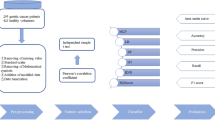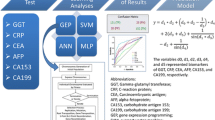Abstract
This study was to explore the application value of back propagation (BP) neural network (BPNN) and genetic algorithm (GA) in the combined detection and prognosis of tumor markers in patients with gallbladder cancer. 446 patients with gallbladder cancer were included in the experimental group, 279 patients with benign gallbladder disease were included in the control group, and 188 healthy people were selected and included in the blank group. Serum tumor markers (CA242, CA199, CEA, and CA125) of the three groups were detected by electrochemical luminescent immune analyzer, and follow-up data for 5 years after surgery were collected. Based on BPNN and GA, an optimization algorithm for multi-tumor markers was constructed and applied to the combined detection of tumor markers in patients. The artificial neural network (ANN), dynamic network biomarker (DNB), auxiliary diagnosis algorithm of the support vector machine (SVM) based on the particle swarm optimization (PSO) (PSO-SVM), matched-pairs feature selection (MPFS) based on the machine learning, and the BPNN were introduced to compare with the algorithm constructed. The diagnostic performances of the algorithms were evaluated with the fivefold cross-validation method. The results showed that the levels of CanAg (CA) 242, carcinoma embryonic antigen (CEA), CA199, and CA125 and positive rates in the experimental group were significantly higher than those in the control group and the blank group (P < 0.05); but the differences between control group and blank group were not visible (P > 0.05). The sensitivity (91.72%) and specificity (87.49%) in detecting CA242 and CA199 based on the proposed algorithm were the highest; the sensitivity (0.9186), specificity (0.8622), and accuracy (94.94%) of the proposed algorithm were higher than those of the conventional algorithms. The postoperative follow-up survival rate of patients in the experimental group was reduced from 41.72% in the first year to 4.28% in the fifth year; tumor node metastasis (TNM) stage IV, neck gallbladder cancer, and CA199 were significantly correlated with the survival rate of patients in the experimental group (P < 0.05). In summary, the combined detection technology of multiple tumor markers based on deep learning algorithms showed excellent diagnostic and prognostic performance for gallbladder cancer. The occurrence of gallbladder cancer was related to the tumor markers CA242, CA199, CEA, and CA125, showing better detection effects by combination of CA242 and CA199. The TNM stage IV, neck gallbladder cancer, and CA199 were independent risk factors for the decrease in survival rate of patients with gallbladder cancer.











Similar content being viewed by others
References
Erlangga Z, Wolff K, Poth T, Peltzer A, Nahnsen S, Spielberg S, Timrott K, Woller N, Kühnel F, Manns MP, Saborowski A, Vogel A, Saborowski M (2019) Potent antitumor activity of liposomal irinotecan in an organoid-and CRISPR-Cas9-based murine model of gallbladder cancer. Cancers 11(12):1904
Liang Y, Li Q, Chen P, Xu L, Li J (2019) Comparative study of back propagation artificial neural networks and logistic regression model in predicting poor prognosis after acute ischemic stroke. Open Medicine 14(1):324–330
Mochizuki K, Hata H, Naitou K, Motosugi U, Kondo T (2020) Carcinosarcoma (adenocarcinoma, neuroendocrine carcinoma, undifferentiated carcinoma and chondrosarcoma) of the gallbladder. Clin J Gastroenterol 13(1):110–115
Geng ZM, Cai ZQ, Zhang Z, Tang ZH, Xue F, Chen C, Zhang D, Li Q, Zhang R, Li WZ, Wang L, Si SB (2019) Estimating survival benefit of adjuvant therapy based on a Bayesian network prediction model in curatively resected advanced gallbladder adenocarcinoma. World J Gastroenterol 25(37):5655–5666
Diana M, Schiraldi L, Liu YY, Memeo R, Mutter D, Pessaux P, Marescaux J (2016) High intensity focused ultrasound (HIFU) applied to hepato-bilio-pancreatic and the digestive system-current state of the art and future perspectives”. Hepatobiliary Surg Nutr 5(4):329–344
Zhang W, Tang G, Zhou S, Niu Y (2019) LncRNA-miRNA interaction prediction through sequence-derived linear neighborhood propagation method with information combination. BMC Genomics 20(11):1–12
Liu J, Li X, Huang J, Liu Y (2019) Matrix metalloproteinase 2 knockdown suppresses the proliferation of HepG2 and Huh7 cells and enhances the cisplatin effect. Open Medicine 14(1):384–391
Elbadawy M, Abugomaa A, Yamawaki H, Usui T, Sasaki K (2020) Development of prostate cancer organoid culture models in basic medicine and translational research. Cancers 12(4):777
Abugomaa A, Elbadawy M, Yamawaki H, Usui T, Sasaki K (2020) Emerging roles of cancer stem cells in bladder cancer progression, tumorigenesis, and resistance to chemotherapy: a potential therapeutic target for bladder cancer. Cells 9(1):235
Akkus Z, Cai J, Boonrod A, Zeinoddini A, Weston AD, Philbrick KA, Erickson BJ (2019) A Survey of deep-learning applications in ultrasound: artificial intelligence-powered ultrasound for improving clinical workflow. J Am Coll Radiol 16(9):1318–1328
Chuang CY, Chang TT, Li DK, Chiu CM, Fang CW, Ng HP, Huang CM, Chen JJ (2020) Colectomy influences the radial pulse parameters of traditional Chinese medicine pulse diagnosis in patients with colorectal cancer. Eur J Integr Med 2020(35):101067
Lasheras JES, Donquiles CG, Nieto PJG, Moleon JJJ, Salas D, Gómez SLS, de la Torre AJM, González-Nuevo J, Bonavera L, Landeira JC, de Cos Juez FJ (2020) A methodology for detecting relevant single nucleotide polymorphism in prostate cancer with multivariate adaptive regression splines and backpropagation artificial neural networks. Neural Comput Appl 32(5):1231–1238
Shakeel PM, Tolba A, Al-Makhadmeh Z, Jaber MM (2019) Automatic detection of lung cancer from biomedical data set using discrete AdaBoost optimized ensemble learning generalized neural networks. Neural Comput Appl 32(3):777–790
García-Díaz P, Sánchez-Berriel I, Martínez-Rojas JA, Diez-Pascual AM (2020) Unsupervised feature selection algorithm for multiclass cancer classification of gene expression RNA-Seq data. Genomics 112(2):1916–1925
Chen ZY, Fu S, Li M, Li MH, Zhang W, Ou HB (2020) Exploring artificial neural network combined with laser-induced auto-fluorescence technology for noninvasive in vivo upper gastrointestinal tract cancer early diagnosis. IJS Oncology 5(1):83
Huang S, Cai N, Pacheco PP, Narrandes S, Wang Y, Xu W (2018) Applications of support vector machine (SVM) learning in cancer genomics. Cancer Genomics Proteomics 15(1):41–51
Dochez V, Caillon H, Vaucel E, Dimet J, Winer N, Ducarme G (2019) Biomarkers and algorithms for diagnosis of ovarian cancer: CA125, HE4, RMI and ROMA, a review. J Ovarian Res 12(1):28
van Erp LW, Cunningham M, Narasimman M, Ali HA, Jhaveri K, Drenth JPH, Janssen HLA, Levy C, Hirschfield GM, Hansen BE, Gulamhusein AF (2020) Risk of gallbladder cancer in patients with primary sclerosing cholangitis and radiographically detected gallbladder polyps. Liver Int 40(2):382–392
Kumar M, Alshehri M, AlGhamdi R, Purushottam S, Vikas D (2020) A DE-ANN inspired skin cancer detection approach using fuzzy C-means clustering. Mobile Netw Appl 25:1319–1329
Zhang ZG, Chen Y, Ji R, Zhao YJ, Wang J, Robinson L, Chen XP, Zhang L (2018) Synchronous cancers of gallbladder carcinoma and combined hepatocellular cholangiocarcinoma: an unusual case and literature review. BMC Cancer 18(1):1046
Kabakov A, Yakimova A, Matchuk O (2020) Molecular chaperones in cancer stem cells: determinants of stemness and potential targets for antitumor therapy. Cells 9(4):892
Wu CH, Luo Y, Fei X, Chou YH, Chiou HJ, Wang HK, Lai YC, Lin YH, Tiu CM, Wang J (2018 Apr) Algorithmic approaches to the diagnosis of gallbladder intraluminal lesions on ultrasonography. J Chin Med Assoc 81(4):297–304
Zhang W, Shi J, Li R, Han Z, Li L, Li GH, Yang B, Yin Q, Wang YY, Ke Y, Li Q (2020) Effectiveness of olaparib treatment in a patient with gallbladder cancer with an ATM-inactivating mutation. Oncologist 25(5):375
Pérez-Palma E, Bustos BI, Lal D, Buch S, Azocar L, Toliat MR, Lieb W, Franke A, Hinz S, Burmeister G, von Shönfels W, Schafmayer C, Ahnert P, Völzke H, Völker U, Homuth G, Lerch MM, Puschel K, Gutiérrez RA, Hampe J, Nürnberg P, Miquel JF, De Ferrari GV (2020) Copy number variants in lipid metabolism genes are associated with gallstones disease in men. Eur J Hum Genet 28(2):264–273
Balakrishnan S, Ibrahim KS, Duraisamy S, Sivaji I, Kandasamy S, Kumarasamy A, Kumar NS (2020) Antiquorum sensing and antibiofilm potential of biosynthesized silver nanoparticles of Myristica fragrans seed extract against MDR Salmonella enterica serovar Typhi isolates from asymptomatic typhoid carriers and typhoid patients. Environ Sci Pollut Res 27(3):2844–2856
Yuza K, Sakata J, Prasoon P, Hirose Y, Ohashi T, Toge K, Miura K, Nagahashi M, Kobayashi T, Wakai T (2019) Long-term outcomes of surgical resection for T1b gallbladder cancer: an institutional evaluation. BMC Cancer 20(1):1–9
Mcgee EE, Koshiol J (2020) Comments on "Should we consider gallbladder cancer a new smoking related cancer? A comprehensive meta-analysis focused on dose-response relationships. Int J Cancer 147(2):593–594
Jin Y, Li F (2020) Comment on: Comparison of oncological outcomes after open and laparoscopic re-resection of incidental gallbladder cancer. Br J Surg 107(6):769–769
Goyal V, Singh G, Tiwari O, Punia S, Kumar M (2019) Intelligent skin cancer detection mobile application using convolution neural network. J Adv Res Dyn Control Syst 11(7):253–259
Wang H, Dong F, Wang Y, Wang X, Hong D, Liu Y, Zhou J (2020) Betulinic acid induces apoptosis of gallbladder cancer cells via repressing SCD1. Acta Biochim Biophys Sin 50(2):200–206
Vega EA, Conrad C (2020) Author response to: is laparoscopic re-resection of incidental gallbladder cancer really non-inferior to the open approach? Br J Surg 107(6):767–768
Wang H, Zhan M, Liu Q, Wang J (2020) Glycochenodeoxycholate promotes the metastasis of gallbladder cancer cells by inducing epithelial to mesenchymal transition via activation of SOCS3/JAK2/STAT3 signaling pathway. J Cell Physiol 235(2):1615–1623
Liska V, Treska V, Skalicky T, Fichtl J, Bruha J, Vycital O, Topolcan O, Palek R, Rosendorf J, Polivka J, Holubec L (2017) Evaluation of tumor markers and their impact on prognosis in gallbladder, bile duct and cholangiocellular carcinomas—a pilot study. Anticancer Res 37(4):2003–2009
Author information
Authors and Affiliations
Corresponding author
Additional information
Publisher's Note
Springer Nature remains neutral with regard to jurisdictional claims in published maps and institutional affiliations.
Rights and permissions
About this article
Cite this article
Chang, Y., Wu, Q., Chi, L. et al. Adoption of combined detection technology of tumor markers via deep learning algorithm in diagnosis and prognosis of gallbladder carcinoma. J Supercomput 78, 3955–3975 (2022). https://doi.org/10.1007/s11227-021-03843-z
Accepted:
Published:
Issue Date:
DOI: https://doi.org/10.1007/s11227-021-03843-z




